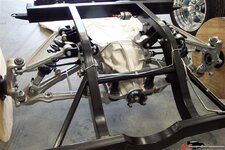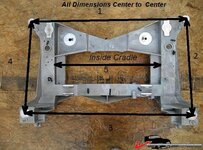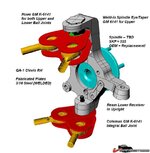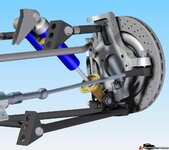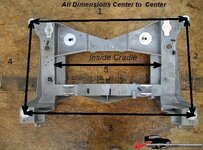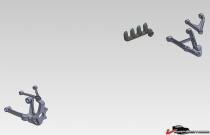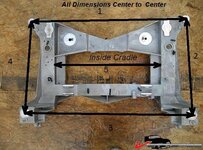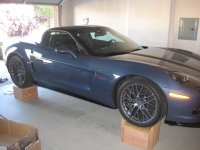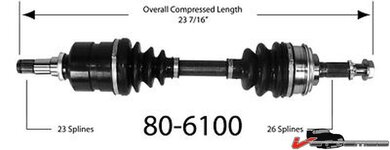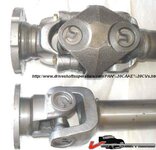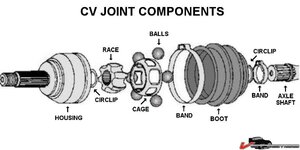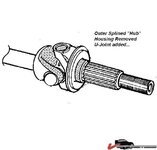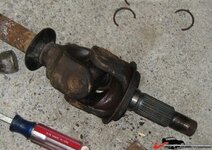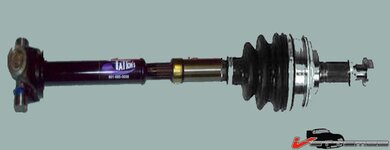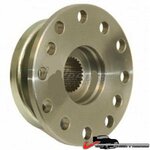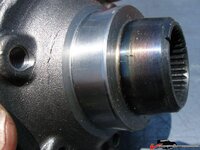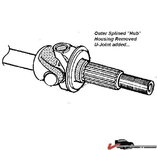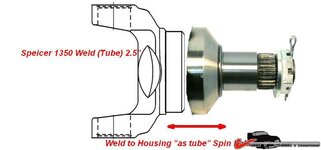mfain
Well-known member
Jim,
Just a thought. If you model the C5/C6 rear suspension geometry, you will see a very low roll center. To balance the suspension, you need to balance the front and rear roll stiffness, which requires an increasing stiff spring rate as the roll center lowers. Some of the C5/C6 suspensions have rear spring rates upwards of 700#/in. You may have to look at the C5/C6 rear monoleafs (or coil-overs) to get that kind of number. You could always raise the rear RC by adjusting the strut rods (or dog bone/a-arm) to change the IC, but that would probably be counter-productive and would eliminate one of the major benefits of the C5/C6 geometry.
As you have heard me say before, I am not fond of slip joint axle shafts because of the friction in the splines under high torque loads. The friction may cause slight binding that can cause unpredictable changes in suspension geometry during cornerning. If you use C5/C6 outer bearings, then it is possible to set up the flanges of Tom's heavy duty inner stub axles to accept a C5/C6 inner CV joint flange. Then you could use the later Corvette axle assemblies -- the CV joints allow for the axle length change during suspension travel, without the friction of splines. If axle length is a problem, it is not super expensive to have the shaft shortened or to have one of the driveline shops (like the Driveshaft Shop) build custom length axles.
I saw something else kind-of interesting the other day in Camaro Performers Magazine. The Driveshaft Shop (I'm starting to sound like a salesman - LOL) built an independant suspension 9-inch center section for a 2011 Camaro that uses a fabricated steel housing and late Corvette-style CV joints and axles. With that housing, you could weld the front and rear mounts anywhere you wanted them (the one for the Camaro actually uses a front mount that bolts to the 9-inch front pinion bearing retainer ring), and you could also weld pickup points for the upper and lower links directly to the housing. Then all you would have to do is fabricate provisions in a rear cross member to bolt the whole thing in.
Like your project -- keep us posted.
Cheers
Just a thought. If you model the C5/C6 rear suspension geometry, you will see a very low roll center. To balance the suspension, you need to balance the front and rear roll stiffness, which requires an increasing stiff spring rate as the roll center lowers. Some of the C5/C6 suspensions have rear spring rates upwards of 700#/in. You may have to look at the C5/C6 rear monoleafs (or coil-overs) to get that kind of number. You could always raise the rear RC by adjusting the strut rods (or dog bone/a-arm) to change the IC, but that would probably be counter-productive and would eliminate one of the major benefits of the C5/C6 geometry.
As you have heard me say before, I am not fond of slip joint axle shafts because of the friction in the splines under high torque loads. The friction may cause slight binding that can cause unpredictable changes in suspension geometry during cornerning. If you use C5/C6 outer bearings, then it is possible to set up the flanges of Tom's heavy duty inner stub axles to accept a C5/C6 inner CV joint flange. Then you could use the later Corvette axle assemblies -- the CV joints allow for the axle length change during suspension travel, without the friction of splines. If axle length is a problem, it is not super expensive to have the shaft shortened or to have one of the driveline shops (like the Driveshaft Shop) build custom length axles.
I saw something else kind-of interesting the other day in Camaro Performers Magazine. The Driveshaft Shop (I'm starting to sound like a salesman - LOL) built an independant suspension 9-inch center section for a 2011 Camaro that uses a fabricated steel housing and late Corvette-style CV joints and axles. With that housing, you could weld the front and rear mounts anywhere you wanted them (the one for the Camaro actually uses a front mount that bolts to the 9-inch front pinion bearing retainer ring), and you could also weld pickup points for the upper and lower links directly to the housing. Then all you would have to do is fabricate provisions in a rear cross member to bolt the whole thing in.
Like your project -- keep us posted.
Cheers

